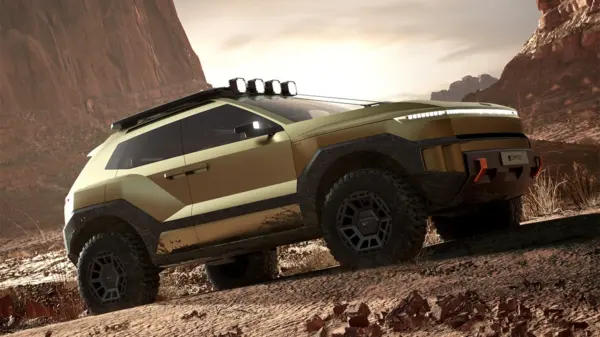Hyundai has introduced an innovative concept vehicle called the Crater, designed for off-road exploration. Unveiled by the company’s design team in Irvine, California, this compact electric SUV features a striking aesthetic reminiscent of a vehicle suited for extraterrestrial missions.
The Crater stands out with its angular bodywork and robust fender design, drawing comparisons to the Warthog from the popular video game franchise, Halo. It is anticipated to be smaller than Hyundai’s Tucson, which could positively impact its electric range. The vehicle is expected to share components with the Ioniq 5, offering an impressive output of 320 hp and 446 lb.ft (or 605 Nm) of torque. Coupled with an 84-kWh battery, the Crater may achieve an estimated range of approximately 350 miles (or 570 km) on a full charge.
Design Features and Innovations
The Crater’s bold design includes a wide hood and narrow strips for headlights and taillights, enhancing its adventurous stance. It rides high on 33-inch tires, ensuring excellent ground clearance for off-road challenges. The vehicle is equipped with a rugged steel skid plate that features bright orange recovery hooks, with one cleverly designed as a bottle opener.
Innovative details abound, such as limb risers—cables that protect the windshield from tree branches while traversing wooded trails. The side mirrors double as detachable cameras, which can be repurposed as handheld action cams, each equipped with flashlights for added utility.
Inside, the Crater showcases a futuristic utilitarian design. The front and rear doors open electronically to reveal an interior inspired by rally car aesthetics, complete with seats mounted on a roll cage. The dashboard consists of a tubular mesh crash pad that emits ambient light, diverging from the conventional touchscreen infotainment systems found in most modern vehicles. Instead, the Crater utilizes a series of gears to adjust off-road driving settings, including locking differentials and traction control.
Interior Comfort and Technology
The cockpit of the Crater is devoid of a traditional cluster display. Instead, crucial information is projected onto the base of the windshield, including the views from external mirrors. The driver can easily switch between drive modes via integrated buttons on the steering wheel, with the active mode displayed on a pixelated screen.
For ergonomic comfort, the seats feature cylindrical cushions and four-point seatbelts, all crafted from durable black leather and Alcantara designed to age gracefully. Brushed metal accents complete the cabin’s rugged aesthetic, reinforcing the Crater’s adventurous spirit.
Although Hyundai has not confirmed plans for production, the Crater represents a bold step in the automaker’s design philosophy. Given the company’s recent successes with concept vehicles, including the five-door Ioniq Concept 3 and the performance-focused Insteroid, the Crater could signal another winner for Hyundai if it moves toward production.
As Hyundai continues to push the boundaries of automotive design, the Crater stands as a testament to the brand’s commitment to innovation and adventure in the electric vehicle market.







































































